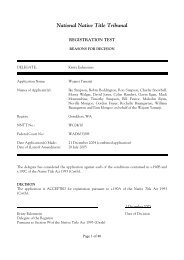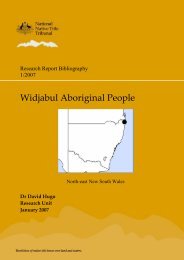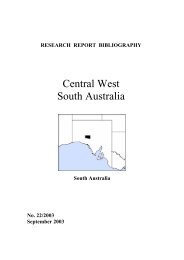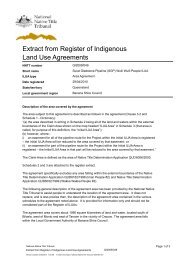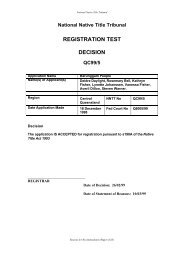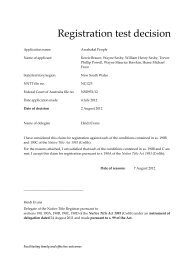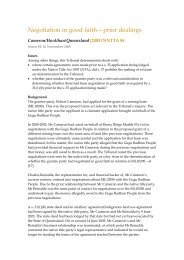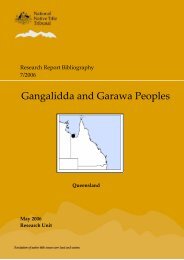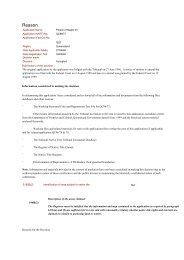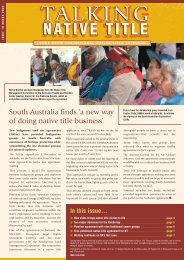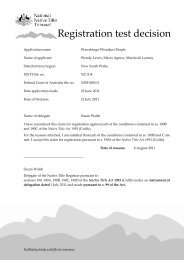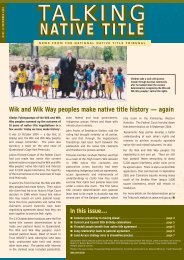Indigenous Cultural Heritage Schemes in Victoria, Queensland and ...
Indigenous Cultural Heritage Schemes in Victoria, Queensland and ...
Indigenous Cultural Heritage Schemes in Victoria, Queensland and ...
Create successful ePaper yourself
Turn your PDF publications into a flip-book with our unique Google optimized e-Paper software.
anyone, <strong>in</strong>clud<strong>in</strong>g the M<strong>in</strong>ister. The relevant Aborig<strong>in</strong>al party must be given the<br />
opportunity to participate. The party undertak<strong>in</strong>g the study may appo<strong>in</strong>t a<br />
suitably qualified cultural heritage assessor to assess the heritage value of the<br />
study area, which can <strong>in</strong>clude an Aborig<strong>in</strong>al person with knowledge of the<br />
Aborig<strong>in</strong>al traditions of the area. Section 53(2)(a) states that Aborig<strong>in</strong>al parties<br />
are responsible for determ<strong>in</strong><strong>in</strong>g the significance of any heritage objects <strong>and</strong><br />
places found dur<strong>in</strong>g a study.<br />
When completed, the chief executive considers the report, <strong>and</strong> if necessary, seeks<br />
expert advice, <strong>and</strong> then decides to either <strong>in</strong>clude or to not <strong>in</strong>clude the results of<br />
the study <strong>in</strong> the register.<br />
Identification <strong>and</strong> consultation of appropriate <strong>Indigenous</strong> parties<br />
Consultation <strong>and</strong> the duty of care<br />
Consultation with relevant <strong>Indigenous</strong> parties is a significant element of the Act.<br />
From a conservation <strong>and</strong> protection po<strong>in</strong>t of view, one of the most important<br />
elements is the role that <strong>in</strong>volv<strong>in</strong>g <strong>Indigenous</strong> parties <strong>in</strong> consultation,<br />
participation <strong>and</strong> agreements plays with<strong>in</strong> the overall process of cultural heritage<br />
assessments. Given that the purpose of a cultural heritage assessment is to<br />
determ<strong>in</strong>e if there are features of cultural heritage significance, <strong>and</strong> if so, how<br />
best to manage the proposed action so that harm is m<strong>in</strong>imised, proponents are<br />
obliged to contact the relevant Aborig<strong>in</strong>al parties so as to seek:<br />
(a) Advice as to whether the feature constitutes Aborig<strong>in</strong>al cultural heritage; <strong>and</strong><br />
(b) If it does, agreement as to how best the activity may be managed to avoid or m<strong>in</strong>imise<br />
harm to any Aborig<strong>in</strong>al cultural heritage. 143<br />
Where agreement cannot be reached, however, the duty of care rema<strong>in</strong>s. As a<br />
consequence, the proponent can seek alternatives beyond agreements with<br />
Aborig<strong>in</strong>al parties, such as through the development of a CHMP. This could be<br />
viewed as offer<strong>in</strong>g proponents a detour around consultation processes, although<br />
CHMPs also require the sponsor to <strong>in</strong>vite the relevant Aborig<strong>in</strong>al party to<br />
contribute to the plan. 144 The duty of care guidel<strong>in</strong>es also state that the ‘views of<br />
the Aborig<strong>in</strong>al Party for an area are key <strong>in</strong> assess<strong>in</strong>g <strong>and</strong> manag<strong>in</strong>g any activity<br />
143 Duty of Care Guidel<strong>in</strong>es, item 5.16.<br />
144 ACH Act, s. 93.<br />
46



